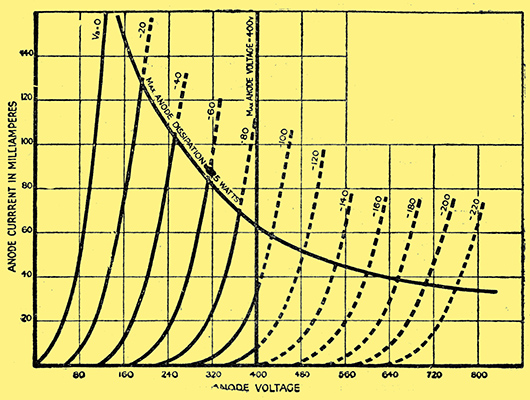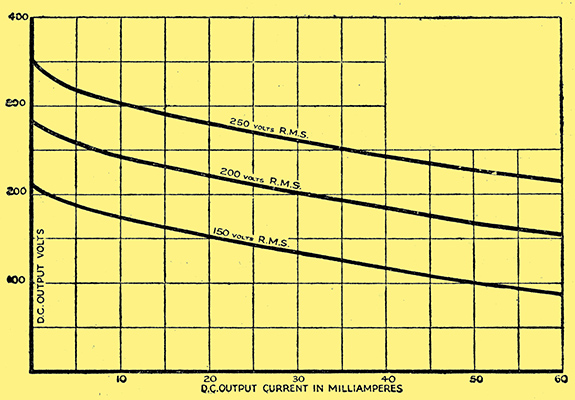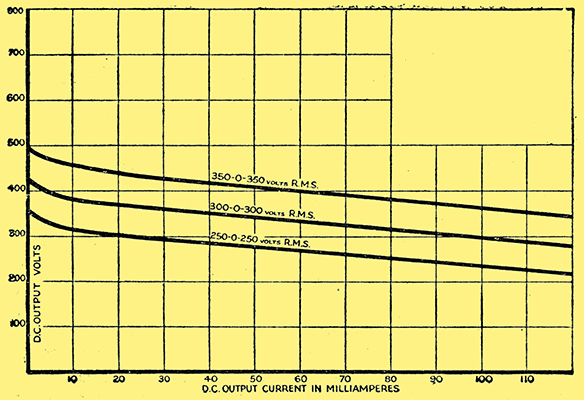|
First details of a new indirectly-heated output valve, and of several other noteworthy advances in valve design.
For a long time we have become so accustomed to the normal type of indirectly-heated AC and DC pentodes, giving an. output power of some 2 to 2.5 W, that we have unconsciously considered that finality has been reached with that particular type of valve design.
Directly-heated pentodes have been produced with larger outputs, but up to the present nothing has been done to improve on the power-delivering properties of the indirectly-heated kind.
During the last week, however, news has reached us of a valve that has quite upset our foregone conclusions concerning these valves, for Mullard have in production an indirectly-heated pentode for AC operation capable of giving the astounding output power of 3.4 W undistorted AC.
In addition, the valve, which is to be known as the Pen4VA, will take a greater grid voltage input than its predecessor, the Pen4V, so that the danger of grid overloading, so common with the indirectly-heated pentode, as we now know it, is greatly reduced.
Here are the characteristics of the Pen4VA, which show at a glance what a particularly useful addition to the ranks of AC valves it is. The heater voltage is 4 Volts, which is quite normal, while the heater current is 1.5 Amp, a slight increase that is not important.
The maximum anode and auxiliary grid voltages are the same, namely 250 Volts, while the optimum load is some 6,000 Ω. The mutual conductance is 3.5 milliamps per volt, and the maximum anode current is about 32 mA, with a grid-bias voltage of -22 Volts. This bias is provided with a cathode resistance of 500 Ω. With an input voltage of 15.5 Volts RMS on the grid the sensitivity of the Pen4VA is some 14 mW/V2, while with an input of 12 Volts RMS the sensitivity is about 17 mW/V2.
High Power Audio

The well-known Mullard DO25 is to be replaced by the DO26, which has the characteristics shown below.
But the pentode is not the only new valve that is shortly to make its appearance. There is the Mullard DO26, which is to supersede the DO25 as an output triode valve in high-power amplifiers. This takes a filament current of 2 Amps at 4 Volts, and has an optimum load of 4,000 Ω. The mutual conductance is 6.3 mA/V, and the anode impedance 600Ω.
With a maximum input voltage on the grid of 65 Volts RMS we get a sensitivity of 1.75 mW per V2, and the maximum power output is 7.5 Watts. The approximate grid bias voltage at the maximum anode potential of 400 Volts is -92 Volts, at which figures an anode current of 62.5 mA flows.
New rectifiers

The curves of the IW2, a Mullard 60 mA indirectly heated rectifier, which is a forthcoming arrival on the market.
Finally, accompanying these valves are two indirectly-heated mains rectifiers, the IW2 and IW3, both from the same stable. The former is to provide a rectified current of 60 mA at 250 Volts, and the other a current of 120 mA at 350 Volts. These valves render voltage surges in the set due to HT application before its valves warm up, impossible.

Accompanying the IW2 is the IW3, which is a similar rectifier, designed to give a greater power output.
|